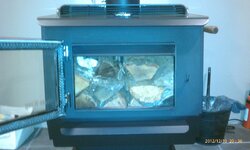Looking for all advice or feedback for princess blazeking, particularly the insert, owners. I have not met anyone yet who owns one so my color and advice is limited.
How bad was your first burn as far as smoke and paint curing was concerned? How do you operate under normal conditions...meaning do you typically keep it on low and feed it every 18 hours? Or do you find yourself doing it twice a day etc. I'll be burning seasoned mixed hardwood. Was there any extra dust in the house or smoke smell. How long do you get on a medium or high setting. What temp are you normally getting at the different settings, etc etc.
I'm just trying to get ideas together for running the stove next year and I'd like to be prepared in any way possible. Thanks in advance,
How bad was your first burn as far as smoke and paint curing was concerned? How do you operate under normal conditions...meaning do you typically keep it on low and feed it every 18 hours? Or do you find yourself doing it twice a day etc. I'll be burning seasoned mixed hardwood. Was there any extra dust in the house or smoke smell. How long do you get on a medium or high setting. What temp are you normally getting at the different settings, etc etc.
I'm just trying to get ideas together for running the stove next year and I'd like to be prepared in any way possible. Thanks in advance,





